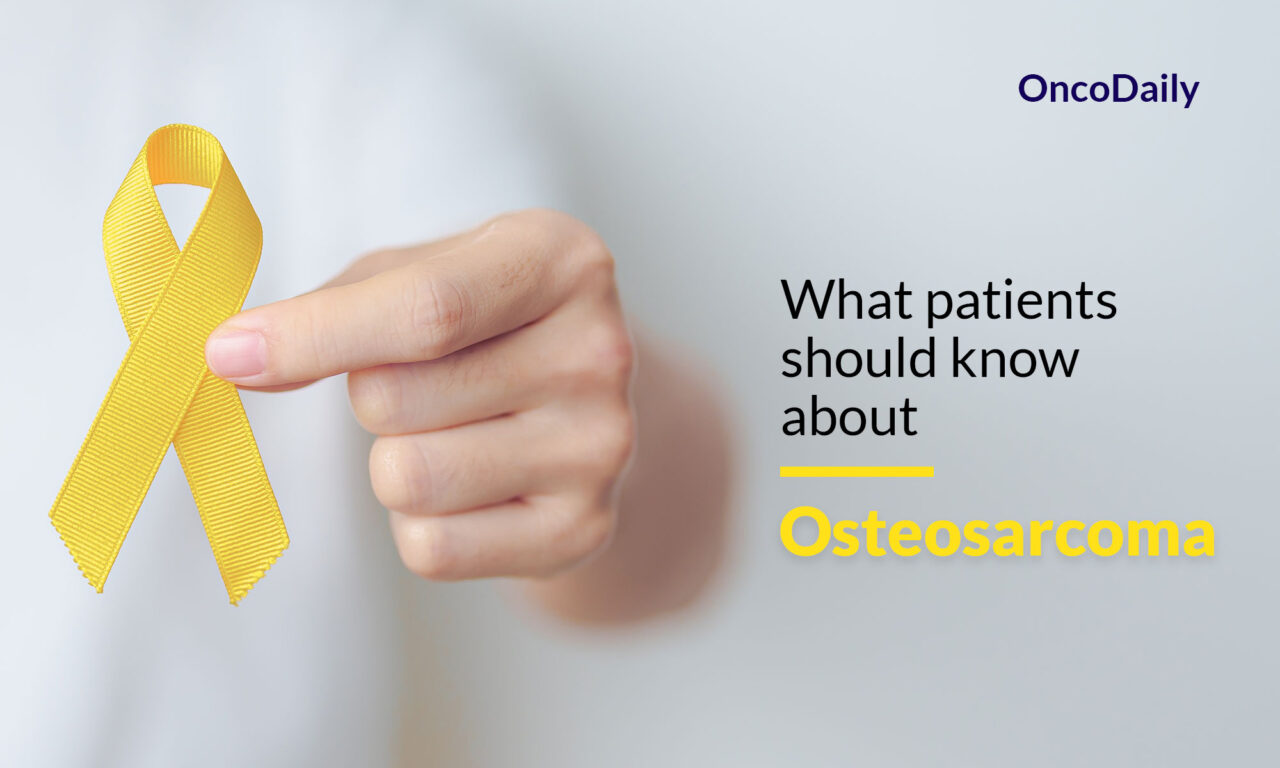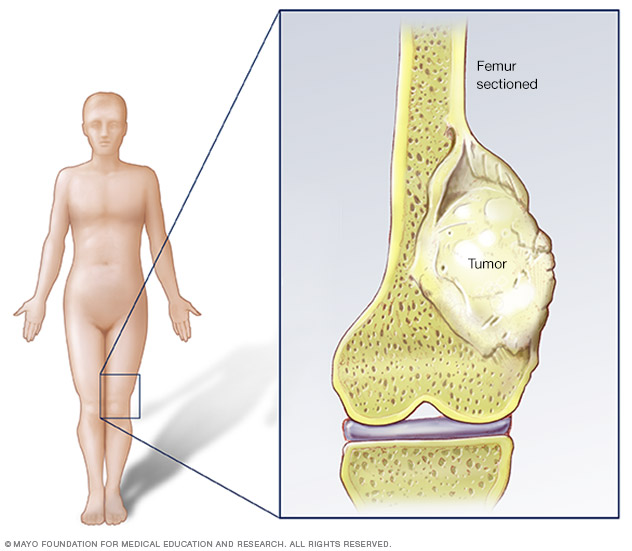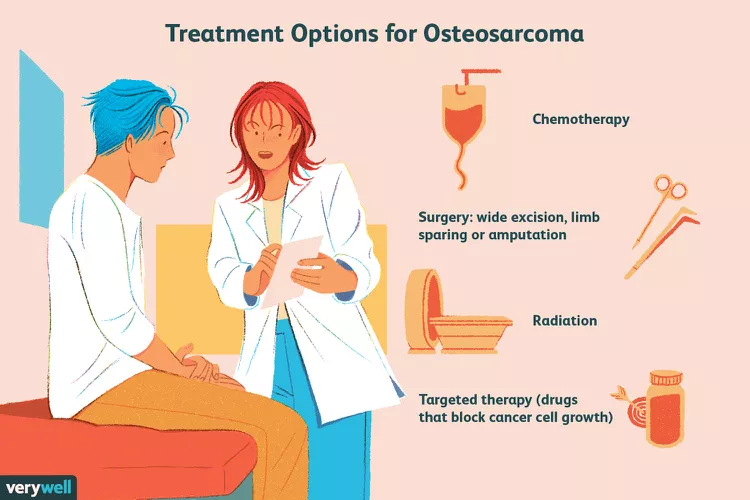
Osteosarcoma: What patients should know about
Introduction, what is osteosarcoma?
Osteosarcoma is a type of bone cancer that typically affects children and young adults. It is the most common type of bone cancer, although it is still considered a rare disease. Osteosarcoma starts in the cells that form bones, known as osteoblasts. These cells begin to grow abnormally and uncontrollably, forming a tumor within the bone.
Osteosarcoma can develop in any bone in the body, but it most commonly occurs in the long bones of the arms and legs, such as the femur (thigh bone), tibia (shin bone), and humerus (upper arm bone). The areas around the knee and shoulder joints are particularly susceptible due to the rapid bone growth that occurs during adolescence.
While osteosarcoma can affect people of any age, it is most prevalent in teenagers and young adults, with the average age of diagnosis being around 15 years old. It is slightly more common in males than females.
Causes, risk factors
The exact cause of osteosarcoma is not fully understood, but it is believed to be a result of genetic mutations that occur within the bone cells. These mutations can be inherited or acquired during a person’s lifetime.
Some known risk factors for osteosarcoma include:
- Age: Osteosarcoma is most common in teenagers and young adults, particularly during periods of rapid bone growth.
- Inherited genetic conditions: Certain inherited genetic disorders, such as Li-Fraumeni syndrome, hereditary retinoblastoma, and Rothmund-Thomson syndrome, increase the risk of developing osteosarcoma.
- Previous radiation therapy: Individuals who have received radiation therapy, especially at a young age or with high doses, have an increased risk of developing osteosarcoma later in life.
- Bone diseases: Certain non-cancerous bone diseases, such as Paget’s disease of the bone and fibrous dysplasia, can increase the risk of osteosarcoma.
- Height: Taller individuals, particularly those who experience rapid growth spurts during adolescence, may have a slightly higher risk of developing osteosarcoma.
It is important to note that many individuals with osteosarcoma do not have any identifiable risk factors, and the disease can occur in people without any known predisposing conditions.

This image is taken from American Childhood Cancer Organiztaion acco.org
Symptoms
The symptoms of osteosarcoma are often related to the location and size of the tumor within the bone. Common symptoms include:
- Bone pain: As the tumor grows within the bone, it can cause persistent and severe pain in the affected area. The pain may initially come and go but gradually becomes constant and worse at night or with activity.
- Swelling: The tumor can cause swelling or a noticeable lump in the area surrounding the affected bone. This is due to the abnormal growth of the tumor cells and the body’s inflammatory response.
- Limping or difficulty moving: If the tumor is located in a weight-bearing bone, such as the leg, it can cause difficulty walking or a noticeable limp. This is because the tumor weakens the bone, making it more susceptible to fractures or instability.
- Bone fracture: In some cases, the tumor can weaken the bone to the point where it breaks, even with minimal trauma. This is known as a pathological fracture and can be a sign of osteosarcoma.
- Fatigue and weight loss: As the tumor grows and the body tries to fight it, some individuals may experience fatigue, weakness, and unintentional weight loss.
It is important to note that these symptoms can also be caused by other conditions, such as sports injuries or growing pains. However, if the symptoms persist or worsen over time, it is crucial to seek medical attention for proper evaluation and diagnosis.
Diagnosis
Diagnosing osteosarcoma typically involves a combination of various tests and procedures:
- Physical examination: A healthcare professional will perform a thorough physical examination, checking for any lumps, swelling, or tenderness in the affected area.
- Imaging tests: X-rays, computed tomography (CT) scans, magnetic resonance imaging (MRI), and bone scans can help detect the presence of a tumor and determine its size and location.
- Biopsy: A biopsy is a procedure in which a small sample of the tumor tissue is removed and examined under a microscope. This is typically done using a needle (core needle biopsy) or through a surgical incision (open biopsy). A biopsy is necessary to confirm the diagnosis of osteosarcoma and distinguish it from other types of bone tumors or conditions.
- Blood tests: While blood tests cannot diagnose osteosarcoma directly, they can provide information about the levels of certain chemicals in the blood, which can help determine the stage and extent of the disease.
- Staging: Once osteosarcoma is diagnosed, additional tests may be performed to determine the stage of the cancer, which indicates how far it has spread. This information is crucial for developing an appropriate treatment plan.
It is important to seek medical attention from experienced healthcare professionals, such as orthopedic oncologists (bone cancer specialists) and multidisciplinary teams, to ensure accurate diagnosis and appropriate treatment planning.
Prognosis
The prognosis, or outlook, for osteosarcoma depends on several factors, including the stage of the cancer at the time of diagnosis, the location and size of the tumor, the patient’s age and overall health, and the response to treatment.
In general, the earlier osteosarcoma is detected and treated, the better the prognosis. Patients with localized osteosarcoma (cancer that has not spread beyond the primary bone) have a higher chance of successful treatment and long-term survival compared to those with metastatic osteosarcoma (cancer that has spread to other parts of the body).
Other factors that can influence the prognosis of osteosarcoma include:
- Age: Younger patients generally have a better prognosis than older patients.
- Tumor size: Smaller tumors are typically easier to treat and have a better prognosis.
- Tumor location: Tumors located in certain bones, such as the pelvis or spine, may be more difficult to treat and have a poorer prognosis.
- Response to treatment: Patients who respond well to chemotherapy and have a good response to treatment generally have a better prognosis.
It is important to discuss the specific prognosis with a healthcare professional, as they can provide more accurate and personalized information based on the individual case.
Treatment, side effects
The treatment of osteosarcoma typically involves a combination of different approaches, including:
- Chemotherapy: Chemotherapy is a crucial component of osteosarcoma treatment. It is typically given before surgery (neoadjuvant chemotherapy) to shrink the tumor and after surgery (adjuvant chemotherapy) to eliminate any remaining cancer cells.
- Surgery: Surgery is an essential part of osteosarcoma treatment. The goal of surgery is to remove the entire tumor and a margin of healthy tissue surrounding it. Depending on the location and size of the tumor, the surgery may involve limb-sparing procedures (removing the tumor while preserving the limb) or amputation (removing the affected limb or part of it).
- Radiation therapy: Radiation therapy is not commonly used as a primary treatment for osteosarcoma, but it may be recommended in certain cases, such as when the tumor cannot be completely removed by surgery or to treat areas where cancer has spread.
- Targeted therapy: Targeted therapies are newer treatments that specifically target the molecular changes in cancer cells. These therapies may be used in combination with chemotherapy or as part of clinical trials for osteosarcoma.
The treatment plan for osteosarcoma is tailored to each individual patient based on factors such as the stage of the cancer, the location and size of the tumor, the patient’s age and overall health, and the potential side effects of the treatment.
Potential side effects of osteosarcoma treatment can vary depending on the specific treatment modalities used and the individual patient’s response. Common side effects may include:
- Chemotherapy side effects: Nausea, vomiting, fatigue, hair loss, increased risk of infections, and bone marrow suppression (low blood cell counts).
- Surgery side effects: Pain, swelling, risk of infection, and potential complications related to the specific surgical procedure.
- Radiation therapy side effects: Fatigue, skin irritation, and potential long-term effects on nearby organs or tissues.
It is important to discuss the potential side effects with the healthcare team and to report any concerns or adverse effects during treatment. Supportive care measures, such as medications to manage nausea or pain, may be provided to help alleviate side effects and improve the patient’s quality of life during treatment.

This image is taken from verywellhealth.com
Newest options and ongoing trials
Research into osteosarcoma treatment is ongoing, with the goal of improving outcomes and reducing side effects. Some of the newest options and ongoing clinical trials for osteosarcoma include:
- Immunotherapy: Immunotherapy is a type of treatment that helps the body’s immune system recognize and attack cancer cells. Several immunotherapy approaches, such as immune checkpoint inhibitors and CAR-T cell therapy, are being investigated for the treatment of osteosarcoma.
- Targeted therapies: Researchers are exploring new targeted therapies that specifically target the molecular changes or pathways involved in osteosarcoma growth and progression. These therapies may be used in combination with chemotherapy or as standalone treatments.
- Personalized medicine: With advances in genomic profiling and molecular testing, researchers are working on developing personalized treatment approaches tailored to the specific genetic and molecular characteristics of each patient’s tumor.
- Novel drug combinations: Clinical trials are evaluating the effectiveness of combining different chemotherapy drugs, targeted therapies, and immunotherapies in new ways to improve treatment outcomes.
- Inhalation chemotherapy: Researchers are investigating the use of inhaled chemotherapy drugs, such as cisplatin, for the treatment of osteosarcoma that has spread to the lungs.
- Surgical techniques: Advances in surgical techniques, such as computer-assisted tumor surgery (CATS) and improved prosthetic devices, aim to improve the outcomes of limb-sparing surgeries and enhance the quality of life for patients.
It is important to note that many of these new options and clinical trials are still in the experimental stages, and their safety and effectiveness are being evaluated. Participation in clinical trials may provide access to promising new treatments, but it is essential to discuss the potential risks and benefits with the healthcare team.
More information about ongoing clinical trials can be found on clinicaltrials.gov
Patient survivorship
Surviving osteosarcoma is a significant achievement, but the journey does not end with the completion of treatment. Many survivors face various challenges and long-term effects related to their cancer experience and the treatments they received.
Some of the common issues that osteosarcoma survivors may encounter include:
- Physical limitations: Depending on the type of surgery performed (limb-sparing or amputation), survivors may experience mobility issues, chronic pain, or limitations in physical activity. Rehabilitation and assistive devices may be necessary to improve function and quality of life.
- Emotional and psychological challenges: Surviving cancer can be emotionally and psychologically challenging. Survivors may experience anxiety, depression, fear of recurrence, or post-traumatic stress disorder (PTSD). Seeking support from mental health professionals, support groups, or counseling can be beneficial.
- Fertility and reproductive concerns: Some cancer treatments, such as chemotherapy and radiation therapy, can affect fertility in both males and females. Fertility preservation options should be discussed with the healthcare team before starting treatment.
- Chronic health conditions: Osteosarcoma survivors may be at an increased risk of developing certain chronic health conditions, such as heart problems, lung issues, or secondary cancers, due to the long-term effects of their treatments.
- Cognitive and learning difficulties: Chemotherapy and radiation therapy can sometimes affect cognitive function, memory, and learning abilities, particularly in younger survivors.
- Social and financial challenges: Cancer treatment and survivorship can have a significant impact on a person’s social life, relationships, and financial well-being. Survivors may face challenges related to employment, insurance coverage, and financial strain.
- Late effects: Some side effects of cancer treatment may not become apparent until years or decades after treatment has been completed. Regular follow-up care and monitoring are essential for detecting and managing any late effects.
It is crucial for osteosarcoma survivors to maintain regular follow-up care with their healthcare team and to address any physical, emotional, or practical concerns that arise. Support services, such as rehabilitation programs, counseling, and survivorship clinics, can help survivors navigate the challenges of life after cancer and improve their overall quality of life.
This fascinating video is taken from City of Hope
Resources
- Osteosarcoma: Causes, Risk Factors, and Symptoms – moffitt.org
- American Cancer Society – cancer.org
- National Cancer Institute – cancer.gov
- What Is Osteosarcoma? – webmd.com
- Survival and prognosis with osteosarcoma: outcomes in more than 2000 patients in the EURAMOS-1 study
- Cumulative Burden of Chronic Health Conditions in Adult Survivors of Childhood Osteosarcoma and Ewing Sarcoma
- Recent and Ongoing Research into Metastatic Osteosarcoma Treatments
- Identifying bone sarcoma survivors facing psychosocial challenges: A study of trajectories following treatment
- Twenty Years of Follow-Up of Survivors of Childhood Osteosarcoma
